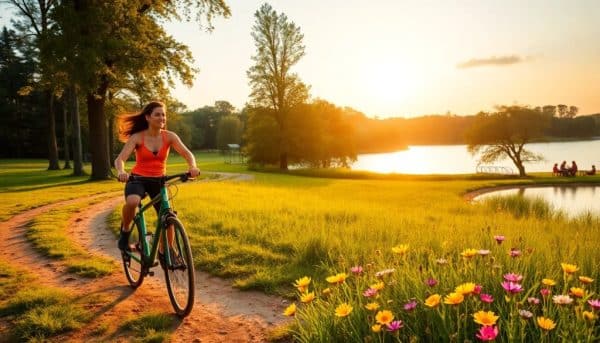Combining cycling with photography allows enthusiasts to explore breathtaking landscapes while capturing stunning moments. This article will guide you through the best spots for capturing nature while cycling, along with tips on how to enhance your photography skills on the road.
From the rugged mountains of Scotland to the serene beaches of Bali, cycling and photography go hand in hand to create unforgettable experiences. Whether you’re an amateur or a professional photographer, these destinations and techniques will elevate your cycling adventures.
What makes a location ideal for cycling and photography?
The ideal location for both cycling and photography should offer a diverse range of landscapes and visual interest. This includes mountains, lakes, forests, and cultural landmarks that provide unique backdrops for your photos.
Accessibility is another crucial factor. Locations that are easy to reach by bike, with safe trails and minimal traffic, ensure a more enjoyable experience. Additionally, the lighting conditions play a vital role; early mornings and late afternoons often provide the best natural light for photography.
- Diverse landscapes for varied photo opportunities
- Accessibility and safe biking paths
- Good lighting conditions for stunning shots
- Rich cultural elements to capture unique stories
- Weather diversity for dramatic scenes
Finally, consider the local flora and fauna. Wildlife sightings can add an exciting element to your photography, making any cycling trip more rewarding.
How to choose the right camera gear for cycling trips?
When it comes to choosing the best camera gear for cycling, portability is key. You want equipment that is lightweight and easy to carry. A compact camera or a smartphone can be great options if you're looking for convenience.
For those who prefer a more advanced setup, consider mirrorless cameras for their balance of quality and size. Look for lenses that cover a range of focal lengths, allowing for flexibility in different shooting situations.
- Choose a lightweight camera, like a mirrorless or compact model.
- Invest in a versatile lens for different shooting scenarios.
- Use protective gear for your camera to shield it from the elements.
- Carry spare batteries and memory cards.
Finally, don’t forget a sturdy yet lightweight tripod. It can be incredibly beneficial for capturing long-exposure shots, especially in low-light conditions.
What are the top cycling destinations for photography in the UK?
The UK is home to some of the most breathtaking cycling routes, perfect for photography enthusiasts. One of the standout locations is the Isle of Skye, known for its dramatic cliffs and stunning vistas. The Old Man of Storr and the Fairy Pools are must-visit spots for capturing incredible landscapes.
Another notable destination is the Jurassic Coast, where the geological formations provide a unique backdrop for photography. The contrast of the sea against ancient cliffs makes for stunning images.
- Isle of Skye: Dramatic scenery and excellent photo opportunities.
- Jurassic Coast: Unique geological formations for striking photos.
- Wales' Snowdonia: Majestic mountain landscapes and rich wildlife.
- Cornwall: Scenic coastlines and charming fishing villages.
Finally, the Scottish Highlands offer breathtaking views that are perfect for capturing the essence of nature. With a combination of mountains, lakes, and rich history, this region is a photographer's paradise.
How to capture stunning photos while bikepacking?
Bikepacking presents unique challenges and opportunities for photography. One of the best ways to capture stunning photos is to plan your stops carefully. Research scenic viewpoints along your route and aim to take breaks in these locations.
Additionally, consider using your bike as a prop. Including your bicycle in the frame can add depth and context to your photos. Play around with different angles and perspectives to enhance visual interest.
Using natural elements to frame your shots can also yield beautiful results. Incorporate trees, rocks, or trails into your composition to create a more dynamic image.
What techniques can improve your bike photography skills?
To enhance your bike photography skills, practice is essential. Make a habit of taking your camera on every ride, focusing on different aspects of your journey each time. This will help you develop a keen eye for interesting compositions and lighting.
Experiment with various settings on your camera, such as adjusting the aperture and shutter speed to see how they affect your photos. High shutter speeds are particularly useful for capturing fast-moving subjects, like fellow cyclists.
- Practice regularly to develop your photography skills.
- Experiment with settings to see how they affect your shots.
- Focus on composition and lighting for enhanced images.
- Engage with the cycling community for tips and feedback.
Lastly, don’t forget to edit your photos after your rides. Post-processing can dramatically improve your images, making colors pop and enhancing the overall quality.
Why is the balance of adventure and photography important in cycling?
Finding the right balance between adventure and photography can elevate your cycling experience. While capturing stunning images is rewarding, it’s essential to enjoy the journey itself. Adventure adds richness to your photography, allowing you to tell a more complete story through your images.
Additionally, engaging with the environment around you helps you appreciate the beauty of each location. This appreciation often translates into more heartfelt and authentic photography.
Furthermore, embracing the unexpected moments during your ride can lead to unique photographic opportunities. Capturing spontaneous events can add character and emotion to your portfolio.
What are the best tips for carrying a camera while cycling?
Cycling with a camera requires some strategic planning. The best way to carry a camera while cycling is by using a well-designed camera bag that fits securely on your bike. Look for bags that offer both protection and accessibility, such as frame bags or handlebar bags.
Alternatively, some cyclists prefer to use specialized camera straps that allow them to carry their cameras directly on their bodies. This method can be particularly convenient for quick shots.
- Use a secure camera bag designed for cycling.
- Consider camera straps for quick access to your camera.
- Protect your camera from the elements with waterproof covers.
- Plan your rides around photo opportunities for better results.
Be mindful of weight distribution as well; a well-balanced setup will enhance your stability while cycling. Always ensure that your equipment is securely fastened before hitting the road.
Related Questions About Cycling and Photography
What camera settings are best for cycling photography?
The best camera settings for cycling photography often depend on the lighting conditions and the type of shots you want to capture. Generally, a fast shutter speed (at least 1/500s) is recommended to freeze motion and avoid blur. You may also want to use a wider aperture (like f/2.8 or f/4) to achieve a shallow depth of field, making your subject pop against the background.
Experimenting with ISO settings can help you adapt to different environments. In brighter conditions, a lower ISO (100-200) is suitable, while in low-light situations, increasing the ISO (800 or higher) can yield better results.
What shutter speed for cycling photography?
A fast shutter speed is crucial for cycling photography. Opt for speeds of at least 1/500s to effectively capture moving subjects without motion blur. If you want to convey a sense of speed, you can experiment with slower shutter speeds while using panning techniques to keep your subject in focus.
Keep in mind that the right shutter speed might vary depending on the speed of your subject and the lighting conditions. Always adjust accordingly.
Where is the best cycling in the world?
Some of the best cycling destinations in the world include the scenic routes of Morocco with its diverse landscapes, Bali’s lush jungles, and the stunning mountain passes of the Alps. Each destination offers unique challenges and breathtaking views, making them ideal for both cycling and photography.
In addition, exploring places like the Pacific Coast Highway in California can provide cyclists with stunning ocean views and picturesque landscapes, perfect for capturing incredible moments.
How to take good photos of a bike?
To take good photos of a bike, focus on composition and lighting. Position the bike against interesting backgrounds, and use natural light for the best results. Low angles can create an impressive perspective, while close-up shots of details can highlight craftsmanship and features.
Don’t hesitate to include elements from your environment, such as natural landscapes or urban settings, to tell a story about your cycling journey. Experiment with different angles and settings to create unique images that capture the essence of your biking experience.


Leave a Reply